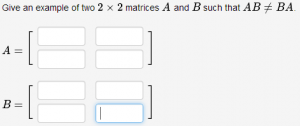Difference between revisions of "MatrixCustomAnswerChecker1"
Paultpearson (talk | contribs) (Add new matrices and custom answer checkers template) |
Paultpearson (talk | contribs) (PGML example link) |
||
| Line 6: | Line 6: | ||
</p> |
</p> |
||
* File location in OPL: [https://github.com/openwebwork/webwork-open-problem-library/blob/master/OpenProblemLibrary/FortLewis/Authoring/Templates/LinAlg/MatrixCustomAnswerChecker1.pg FortLewis/Authoring/Templates/LinAlg/MatrixCustomAnswerChecker1.pg] |
* File location in OPL: [https://github.com/openwebwork/webwork-open-problem-library/blob/master/OpenProblemLibrary/FortLewis/Authoring/Templates/LinAlg/MatrixCustomAnswerChecker1.pg FortLewis/Authoring/Templates/LinAlg/MatrixCustomAnswerChecker1.pg] |
||
| + | * PGML location in OPL: [https://github.com/openwebwork/webwork-open-problem-library/blob/master/OpenProblemLibrary/FortLewis/Authoring/Templates/LinAlg/MatrixCustomAnswerChecker1_PGML.pg Authoring/Templates/LinAlg/MatrixCustomAnswerChecker1_PGML.pg] |
||
<br clear="all" /> |
<br clear="all" /> |
||
Revision as of 16:22, 14 June 2015
Matrices and Custom Answer Checkers
This PG code shows how to use a multianswer answer checker to evaluate an open-ended question about matrices.
- File location in OPL: FortLewis/Authoring/Templates/LinAlg/MatrixCustomAnswerChecker1.pg
- PGML location in OPL: Authoring/Templates/LinAlg/MatrixCustomAnswerChecker1_PGML.pg
| PG problem file | Explanation |
|---|---|
|
Problem tagging: |
|
DOCUMENT(); loadMacros( "PGstandard.pl", "MathObjects.pl", "parserMultiAnswer.pl", "AnswerFormatHelp.pl", "PGcourse.pl", ); $showPartialCorrectAnswers = 0; TEXT(beginproblem()); |
Initialization: |
Context('Matrix');
$A = Matrix([[1,1],[0,1]]);
$B = Matrix([[1,0],[1,1]]);
$multians = MultiAnswer($A, $B)->with(
singleResult => 1,
checker => sub {
my ( $correct, $student, $answerHash ) = @_;
my @s = @{$student};
$s0 = Matrix($s[0]);
$s1 = Matrix($s[1]);
return $s0 * $s1 != $s1 * $s0;
}
);
|
Setup:
Construct two matrices |
Context()->texStrings;
BEGIN_TEXT
Give an example of two \( 2 \times 2 \) matrices \( A \) and \( B \)
such that \( AB \ne BA \).
$BR
$BR
\( A = \)
\{ $multians->ans_array(5) \}
$BR
$BR
\( B = \)
\{ $multians->ans_array(5) \}
END_TEXT
Context()->normalStrings;
|
Main Text:
Make sure that both answer arrays are called as methods on the |
install_problem_grader(~~&std_problem_grader);
ANS( $multians->cmp() );
COMMENT('MathObject version.');
ENDDOCUMENT();
|
Answer Evaluation: |
